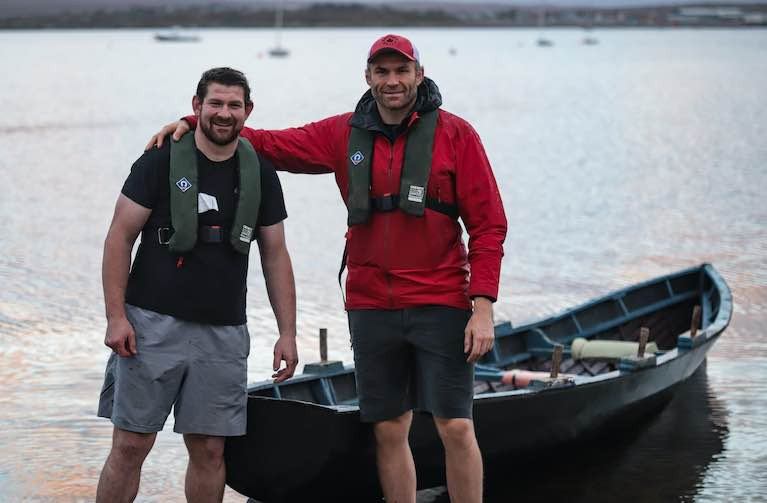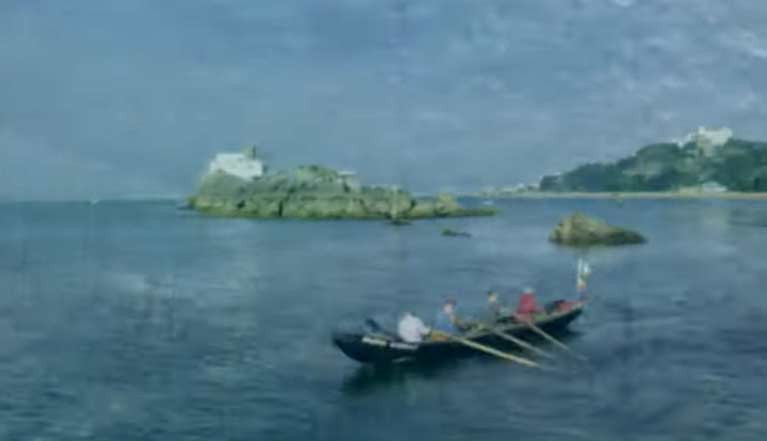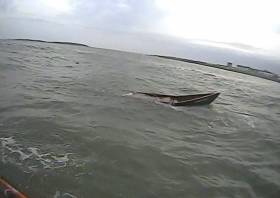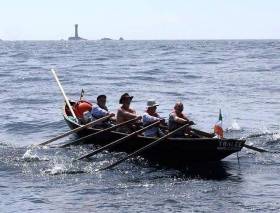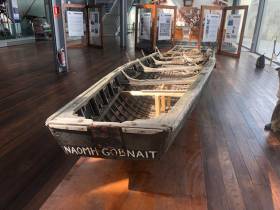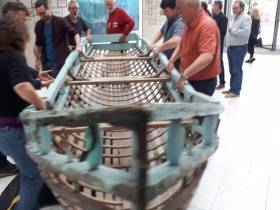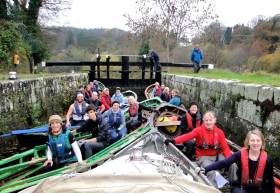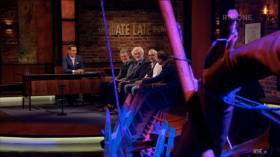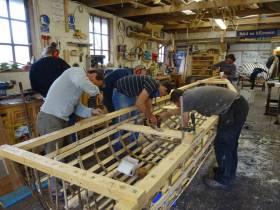Displaying items by tag: Currach
Currach Crossing by Two Galway Rugby Players Planning Transatlantic Row
Two extraordinary men are set to row a currach from the Aran island of Inis Oírr to Galway city this morning to highlight their bid to cross the Atlantic in 2022.
Extreme adventurer and former professional rugby player Damian Browne and his lifelong friend Fergus Farrell aim to set a new Guinness world record in an unsupported row some 4,937km across the Atlantic in two years’ time.
Weather permitting, their 40 km (25-mile) row today (Tues 27th) launches the project’s crowdfunding campaign and symbolises the last leg of their Atlantic traverse.
The two men from Renmore, Galway city, and Athenry, Co Galway respectively have been friends and rugby players with Connacht and Galwegians Rugby Football Club since they were young.
Two years ago, Farrell became paralysed after a workplace accident and was diagnosed with a serious spinal cord injury.
After treatment in the National Rehabilitation Hospital (NRH) in Dun Laoghaire, Co Dublin, he walked 206 km from the place of his accident to the NRH.
Farrell raised 70,000 euro in his “Toughest Trek” for the hospital in late October, 2019.
Browne has completed the six day, 257km-long Marathon des Sables across the Sahara Desert - also known as “The Toughest Footrace on Earth” - and successfully rowed across the Atlantic solo in late 2017-early 2018.
One of just 60 people to complete the crossing alone, he endured nine-metre high swells, deep lacerations on his head, and a complete steering system failure. His boat capsized in a storm and was almost destroyed by an oncoming cargo ship.
He had lost 28 kilos when he completed the crossing in 63 days, 6 hours and 25 minutes. Browne is also multi-time Irish indoor rowing champion and currently holds the all-time records for the 500m and 1000m distances.
To date, he has raised over €100,000 for Irish and African based charities through his extreme adventures and is a founder and leader of Freezbrury, an international group challenge held annually every February .
He has also climbed five of the seven summits or highest peaks on each continent, and aims to tackle Everest in April/May 2021.
The record for an Atlantic crossing from New York to the Scilly isles still stands since set by George Harboe and Frank Samuelsen in 1896 - taking 55 days and 13 hours.
They had no water makers or satellite phones, GPS, emergency position indicating radio beacons ( EPIRBs) or even a life raft on board, Browne and Farrell note.
Some 11 pairs have attempted to better it, but failed, with six of the 11 completing the crossing.
There have been 52 previous attempted crossings in an unsupported row, with 18 successfully making land in some part of Europe.
Browne and Farrell have initiated Project Empower, which they describe as a “24-month studied endeavour in human empowerment”.
Their ocean rowing boat will be built by master builder Justin Adkin of Seasabre, who also constructed Browne’s vessel for his transatlantic row. The craft will be a “classic design”.
Musician Glen Hansard has paid tribute to west Kerry poet, farmer and sailor Danny Sheehy with a new video marking the third anniversary of his death.
Film-maker Dónal Ó Céilleachair, who recorded The Camino Voyage documenting Sheehy’s currach trip with the fellow crew from Ireland to northern Spain, has participated with Hansard in the video release.
Sheehy, an award-winning writer, died in June 2017 when the currach, Naomh Gobnait, was caught by a wave close to the Minho river estuary on the Spanish-Portuguese border. He was just 66 years of age.
Hansard said he wrote the piece, entitled Good Life of Song while staying at the Centre Culturel Irlandais in Paris.
“It’s a tribute to the life of bards and troubadours on their lifelong march through the towns and village of the world, singing and drinking, expressing the sorrows and joys of the age as they court darkness and light with equal knowing,” Hansard has said.
Hansard described it as a “song of gratitude for the gift of singing”.
“I raise it here to the memory of our boat captain, Danny Sheehy,” he said.
Ó Ceilleachair said that “in the face of all the challenges of the present moment, sometimes it is good to pause and give gratitude for the things we do have”.
“With gratitude to your contagious, magnetic, inspiring presence, Danny – Bail ó Dhia ort,” he added, marking the video release with Hansard.
Hansard signed up as crew for the final stage of the three-summer currach voyage from Ireland to northern Spain which was completed in late June 2016.
Sheehy and his close friend, west Kerry musician and oarsman Breanndán Ó Beaglaoich, decided to continue to navigate the Galician and Portuguese coasts in 2017, along with musician Liam Ó Maonlaí of the Hothouse Flowers and Co Cork boatbuilder Padraig Ua Duinnín.
The crew stayed with the upturned craft after its capsize, but Sheehy was taken ill on reaching shore and did not survive.
Better-known in his native Kerry as Domhnall Mac Síthigh, Sheehy won Oireachtas awards for his poetry and storytelling and was a broadcaster on Raidió na Gaeltachta and RTÉ Radio.
He had previously circumnavigated Ireland in a naomhóg with Ger Ó Ciobháin in 1975 and also rowed to Iona in Scotland, while also undertaking several sailing voyages west and north.
Skerries Lifeboat Tasked To Capsized Currach
Skerries RNLI launched to the rescue of a man and two teenagers in the water after their currach capsized off the north Co Dublin town yesterday evening (Saturday 21 September).
Just after 5pm, Dublin Coast Guard picked up a Mayday transmission from the 14ft currach. Skerries RNLI says that at first the location was unclear.
But several 999 calls from concerned onlookers confirmed that it was near the port lateral marker, known locally as the Perch Mark, just off the headland in Skerries.
The volunteer RNLI crew launched their Atlantic 85 inshore lifeboat Louis Simson to the stricken vessel, which could be seen from the lifeboat station.
Arriving on scene at the same time as the Irish Coast Guard helicopter Rescue 116, the crew learned that Skerries Sailing Club’s tender had also picked up the Mayday and, together with another local angling boat, had taken the man and teenagers from the water.
The casualties were then transferred to the lifeboat and brought ashore and to dry off and warm up. Dublin Fire Brigade paramedics attended to give first aid before a HSE ambulance arrived and gave the trio a full checkover.
Meanwhile, Skerries RNLI reports that the capsized currach was returned to the beach and the oars and other items lost overboard were recovered.
“Accidents can happen at sea at any time,” said Skerries RNLI press officer Gerry Canning. “Everyone on board was wearing a lifejacket, and they had a waterproof VHF to raise the alarm, which is really encouraging to see.
“This was a great team effort across multiple different emergency services with everyone playing their part. We’d also like to commend the young man driving the boat for Skerries Sailing Club and the local angling boat for their swift actions.”
On what type of boat did the original settlers of Ireland arrive?
They probably came over 10,000 years ago and began populating the coastal regions.
Could they have come on some type of sailing currach?
The Currach Association of Ireland has been discussing the historic aspects of Ireland’s most iconic boat as they focus on ensuring its protection and preservation for the future. From the paintings of Robert O’Flaherty’s classic film ‘Man of Aran’ through photographs and films, the currach identifies maritime ‘Irishness’ in a way few other symbols achieve.
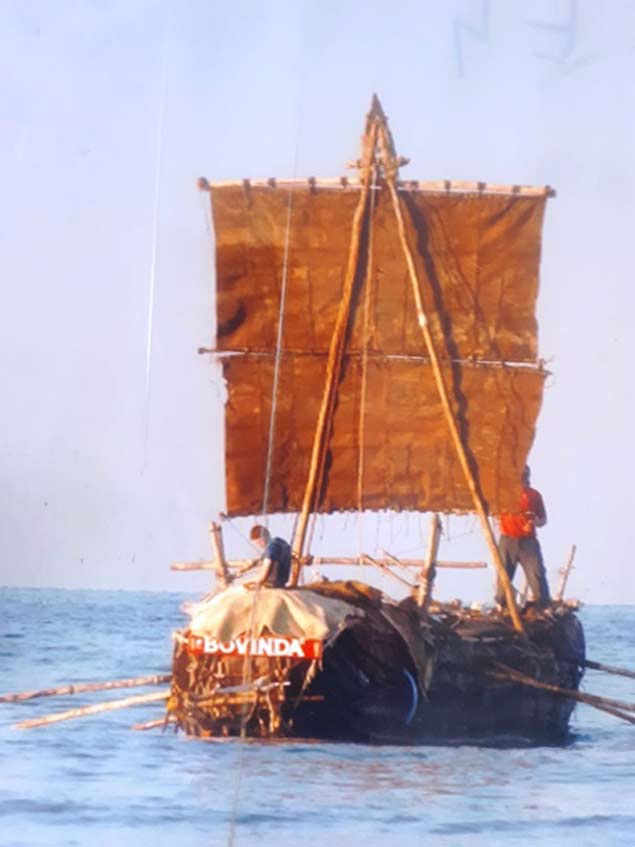 Experimenting with a Sailing Currach version on the River Boyne
Experimenting with a Sailing Currach version on the River Boyne
“People assume that because they are iconic, with the imagery they have, that the currachs will always be there, but will they, if nothing is done to ensure their future?” That is the focus of the Association.
"Could the original settlers to Ireland have come on some type of sailing currach, 10,000 years ago?"
There is a passion amongst those who love currachs which is uplifting to experience.
They are proud of their boats and the Irish maritime history and culture they resonate. Martin O’Donoghue is one of the leaders who outlines how and why it was founded on my Podcast this week and that it is particularly interested to hear where currachs are used.
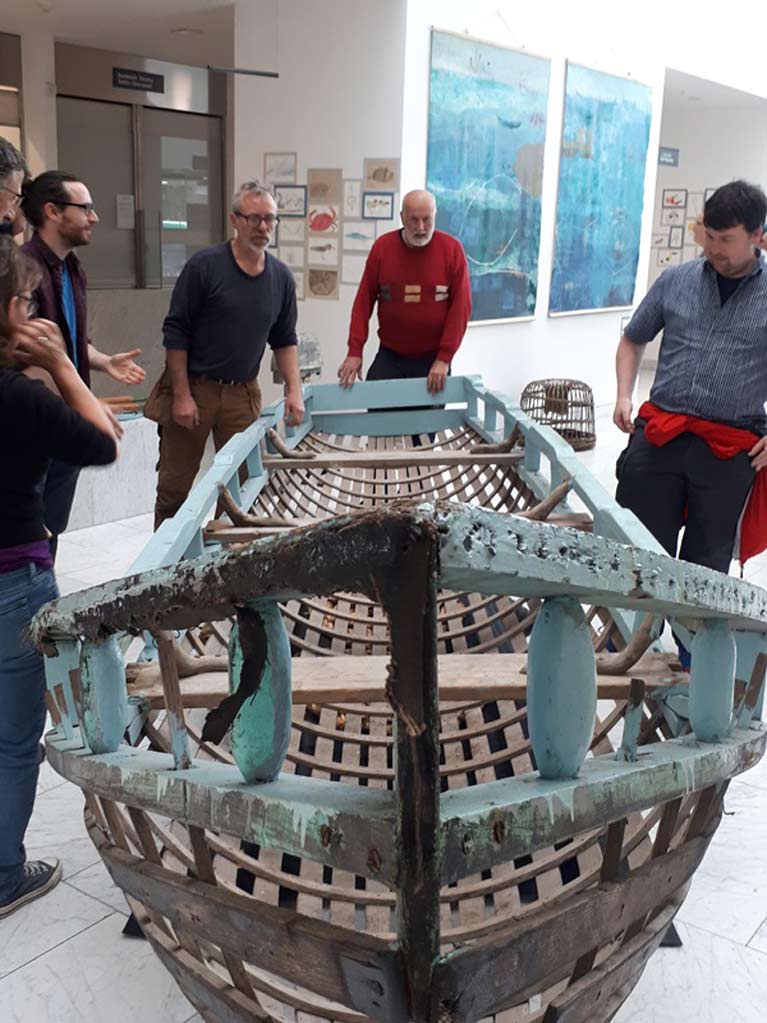 The Currach Association of Ireland are preserving Currachs
The Currach Association of Ireland are preserving Currachs
I was fascinated to hear Claidhigh O’Gibne talk about the research and development of the Boyne sailing currach, made from traditional skin-on-frame. That reminded me of interviewing Tim Severin on television many years ago when he was recreating St.Brendan’s leather boat journey across the Atlantic.
“We are people of the sea, it is our heritage. We must know about our history and skin boats are that history. It is important for young people to understand our history and culture of the sea.” Claidhigh said. He talked about the making of leather sails, the challenge of handling them on a boat and getting that boat to sail.
“The public view is of black boats that all seem alike, but few boats are as varied. There’s enough interest and activity related to currachs going on around the entire island of Ireland, but we have to be certain of preserving their iconic culture and history,” says Martin O’Donoghue on behalf of the Currach Association.
LISTEN TO HIM ON THE PODCAST BELOW
Naomhoga Chorcaigh to Row in Navigatio Santander & Pay Respects to Late Poet Danny Sheehy
Traditional Irish currachs will compete in a Spanish rowing race next week and the crews also hope to will visit the Galician Naomhog exhibition dedicated to the memory of the late poet Danny Sheehy.
Naomhoga Chorcaigh is taking six currachs to Santander next week for a trial version of “Navigatio Santander” – a 22-km rowing race being developed in the fashion of Cork’s Ocean to City Event in Spain.
After the race, the boats will be taken to Vigo where the group that includes Drascombe and traditional boat sailor Jack O'Keefe will visit the Naomhog exhibition reported by Afloat here.
If the weather allows – the currachs will be rowed from Vigo to A Guarda to participate in the 14th Encontro de Embarcationes de Galicia. More here.
As Afloat readers will know, A Guarda is where Danny Sheehy was lost – and the Cork crew intend to pay their respects.
When west Kerry poet, farmer and sailor Danny Sheehy lost his life during the last stages of a “camino by sea” off the Spanish coast two years ago, his fellow oarsmen were so heartbroken they could barely think about the boat that had saved them writes Lorna Siggins.
There is also a tradition that if a currach or naomhóg loses crew to the elements, it does not launch again.
However, the naomhóg Naomh Gobnait is now being restored by Sheehy’s fellow seafarers, with the support of a Galician cultural association in northern Spain.
As Afloat reported in 2017, the 66-year-old award-winning writer had rowed and sailed the Naomh Gobnait on the Camino na Sáile. The three-summer voyage from Ireland to northern Spain completed in late June 2016 was documented by film-maker Dónal Ó Céilleachair.
"There is also a tradition that if a currach or naomhóg loses crew to the elements, it does not launch again"
Some of the crew then decided to continue to navigate the Galician and Portuguese coasts during the summer of 2017, but the boat capsized when caught by a wave close to the Minho river estuary on the Spanish-Portuguese border.
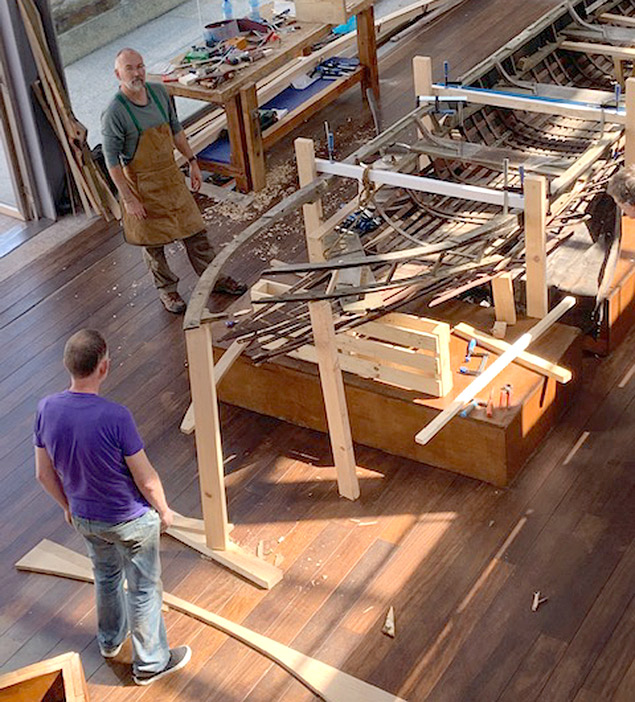 Liam Holden (in foreground), and Breandán Moriarty are among crew of the Camino by Sea voyage now repairing the vessel in Spain, and it will be put on display in either Vigo or in Santiago de Compostella
Liam Holden (in foreground), and Breandán Moriarty are among crew of the Camino by Sea voyage now repairing the vessel in Spain, and it will be put on display in either Vigo or in Santiago de Compostella
Musician Liam Ó Maonlaí of the Hothouse Flowers, west Kerry musician and oarsman Breanndán Ó Beaglaoich and Co Cork boatbuilder Padraig Ua Duinnín stayed with the upturned craft, along with Sheehy, but he was taken ill and did not survive.
Ó Beaglaoich, who has recently returned from Vigo where the reconstruction is taking place, said that at first everyone had wanted to burn the naomhóg.
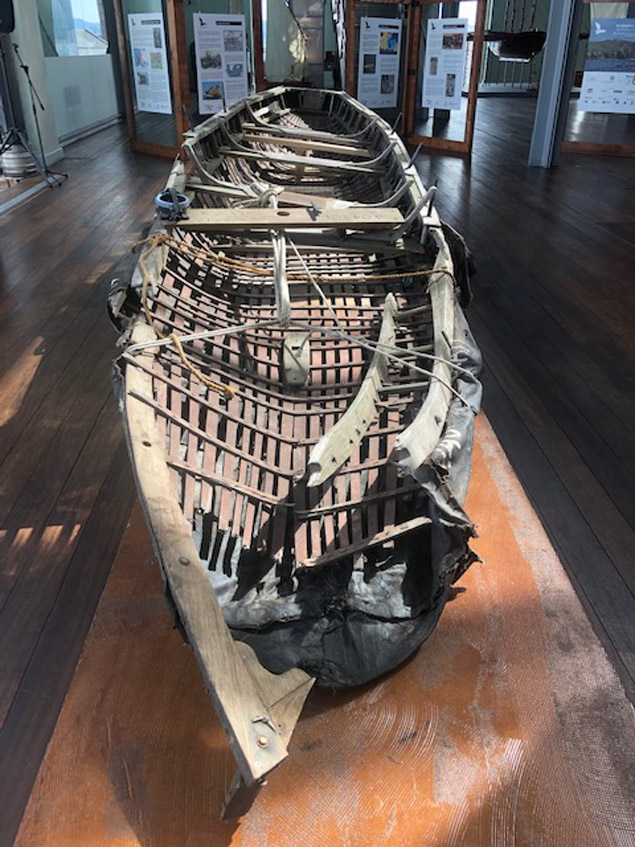 An exhibition about the reconstruction of Naomh Gobnait has also been put together with the support of Buxa, the Galician association of industrial heritage, the Museum of the Sea in Galicia and Galician Television
An exhibition about the reconstruction of Naomh Gobnait has also been put together with the support of Buxa, the Galician association of industrial heritage, the Museum of the Sea in Galicia and Galician Television
“I pleaded for the naomhóg to be saved, as it saved all our lives and it brought Danny back to shore,” he said. “And it came to shore itself in perfect condition. It won’t go back to sea, but it will be a symbol of Irish-Galician links.”
Artist Liam Holden, who built the original craft and is now working on the rebuild with Ó Duinnín, said the boat had been badly damaged from Sheehy’s seat up. However, it is hoped to have most of the repair work completed this week (June 18).
“It is like an emotional healing to see it coming together again,” Ó Beaglaoich said.
“At the time of the capsize, the boat looked like how I felt, but now it looks like how I am feeling now.”
“The naomhóg has Danny written all over it,” he said.
Better-known in his native Kerry as Domhnall Mac Síthigh, Sheehy won Oireachtas awards for his poetry and storytelling and was a broadcaster on Raidió na Gaeltachta and RTÉ Radio.
Sheehy had previously circumnavigated Ireland in a naomhóg with Ger Ó Ciobháin in 1975 and also rowed to Iona in Scotland, while also undertaking several sailing voyages west and north.
An exhibition about the reconstruction of Naomh Gobnait has also been put together with the support of Buxa, the Galician association of industrial heritage, the Museum of the Sea in Galicia and Galician Television.
“The boat is fated to become the symbol of the Santiago pilgrimage by sea, consolidating at the same time the historical relationships between Ireland and Galicia,” the exhibition records.
It also marks the essential sea and shore support provided to the Camino crew of Sheehy, Ó Beaglaoich, Holden, Breandán Moriarty and musician Glen Hansard.
Ó Beaglaoich said that while the plan was to display Naomh Gobnait in Vigo, he would also love to see it exhibited at the Irish College in Santiago de Compostela, which educated hundreds of Irish clerical students from 1605 after the flight of the earls and the later imposition of Penal Laws.
Currachs are Important to Irish History
Currachs are important to preserving the maritime history and culture of an island nation a seminar about these iconic boats was told in Cork Harbour today reports Tom MacSweeney. The seminar on the antiquity and sustainability of currachs was part of the Seafest maritime festival in the city.
Martin O'Donoghue of the Currach Association said that currachs had become part of leisure boating interest which had increased their popularity but there is also a huge educational and cultural aspect which is important to keeping the maritime importance of an island nation to the attention of the present generation.
There are speakers and people attending from around the country and from Norway.
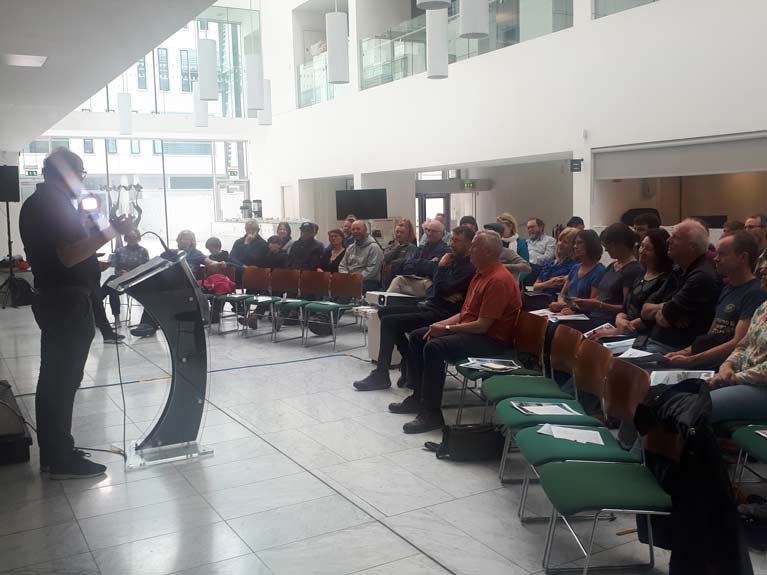 The Cork seminar on the antiquity and sustainability of currachs was part of Seafest
The Cork seminar on the antiquity and sustainability of currachs was part of Seafest
Cork Take on Kilkenny - in Currachs
The keen November sailors of Crosshaven, Dun Laoghaire, Howth and Bangor weren’t the only ones to get a bonus afloat from the weekend’s almost freakish sunshine before the first real hints of winter arrived today writes W M Nixon. The Cork city currach club Naomhoga Chorcai - a sub-group of that remarkable all-encompassing Leeside institution Meithal Mara – undertook a friendly invasion of the sublime yet often secret waterways of Ireland's southeast in the ideal weather window, and they neatly fitted in a complex yet worthwhile programme.
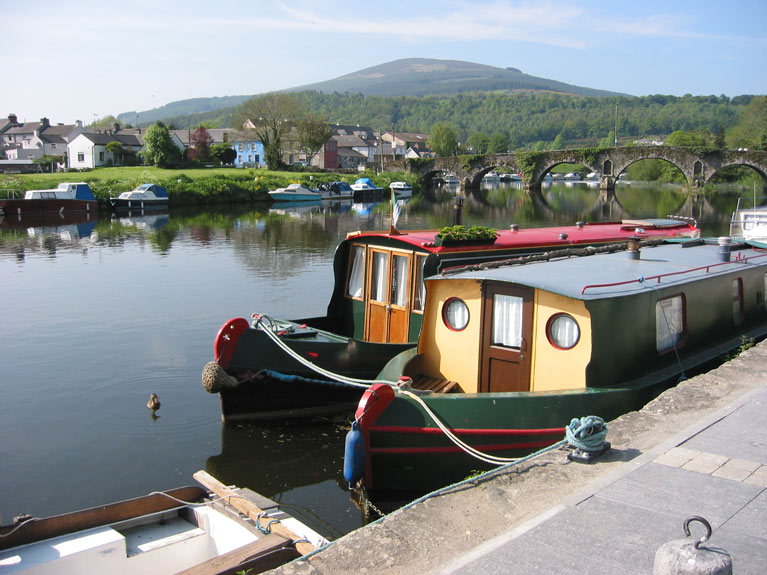 Starting port – Graiguenamanagh in County Killkenny with its famous bridge. Photo: W M Nixon
Starting port – Graiguenamanagh in County Killkenny with its famous bridge. Photo: W M Nixon
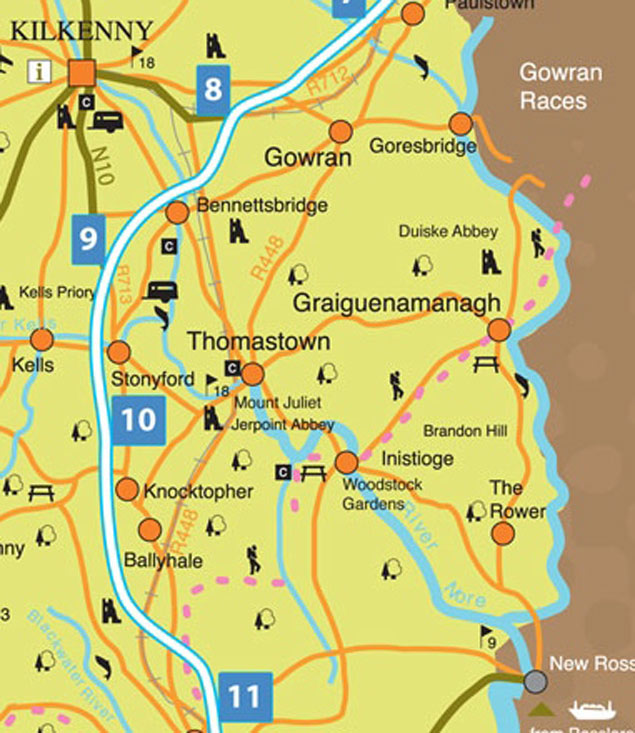 Secret waterways – the Cork currachs rowed along the Kilkenny-Carlow border on the River Barrow from Graiguenamanagh to overnight at New Ross, and then went up-country next day by the River Nore to the hidden port of Inistiog
Secret waterways – the Cork currachs rowed along the Kilkenny-Carlow border on the River Barrow from Graiguenamanagh to overnight at New Ross, and then went up-country next day by the River Nore to the hidden port of Inistiog
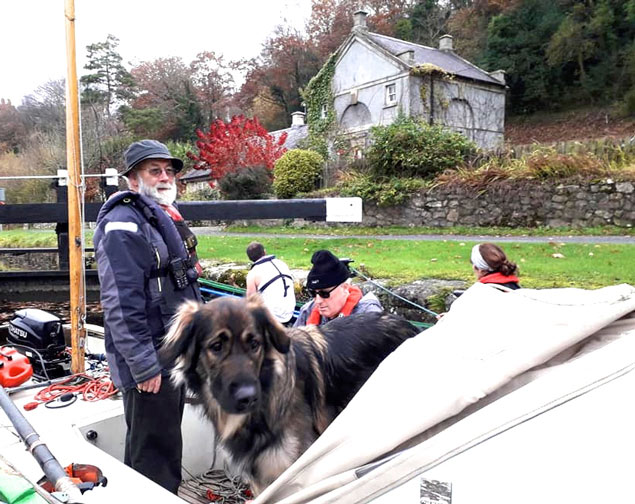 Jack O’Keeffe at Tinnahinch on Tybot with Alan MacNamidhe’s guide dog Pippa
Jack O’Keeffe at Tinnahinch on Tybot with Alan MacNamidhe’s guide dog Pippa
They had themselves a fine old time in the last of the Autumn colours, rowing down the River Barrow from Graiguenamanagh with four locks of the Barrow Navigation to negotiate before overnighting at New Ross, and then next day rowing back up the Barrow again in Sunday’s sunshine to take a left into the River Nore, with a brisk final pluck upstream to finish their inland voyaging at Inistioge.
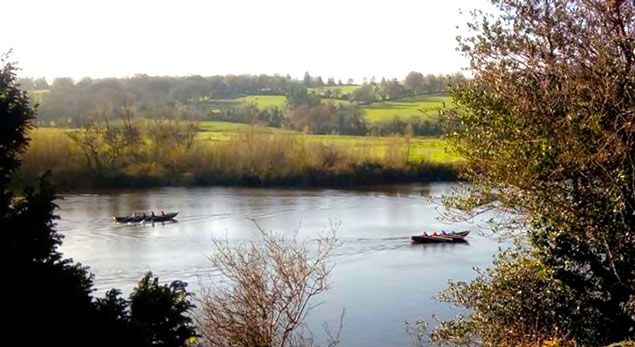 A new currach-rowing waterway is found deep in Ireland’s southeast. Photo: John Diamond
A new currach-rowing waterway is found deep in Ireland’s southeast. Photo: John Diamond
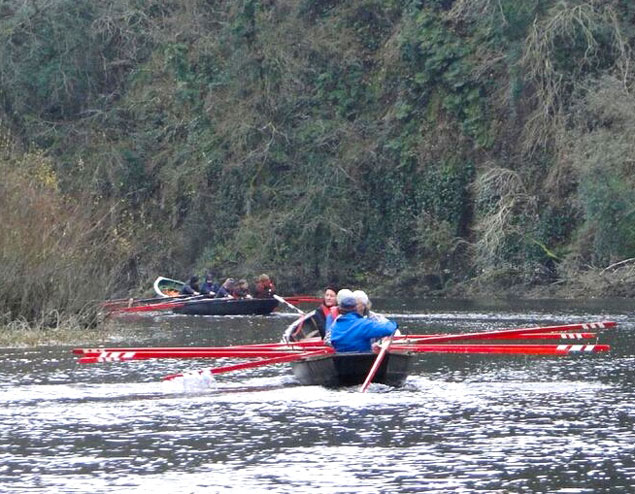 What’s to be found round the next bend in the river? There’s only way one way to find out….Photo: Jack O’Keeffe
What’s to be found round the next bend in the river? There’s only way one way to find out….Photo: Jack O’Keeffe
With five currachs and organizer Jack O’Keeffe’s Drascombe Coaster Tybot as mother-ship to make up a tidy flotilla crewed by a total of 26 voluntary rowers plus Pippa, friendly guide-dog to blind oarsman Alan MacNamidhe, the logistics alone would have defeated many larger organisations.
But Naomhaga Chorcai seem to think as one, and act in unison and effortless co-operation to get boats and people here, there and wherever else is necessary with a minimum of fuss, leaving no trace.
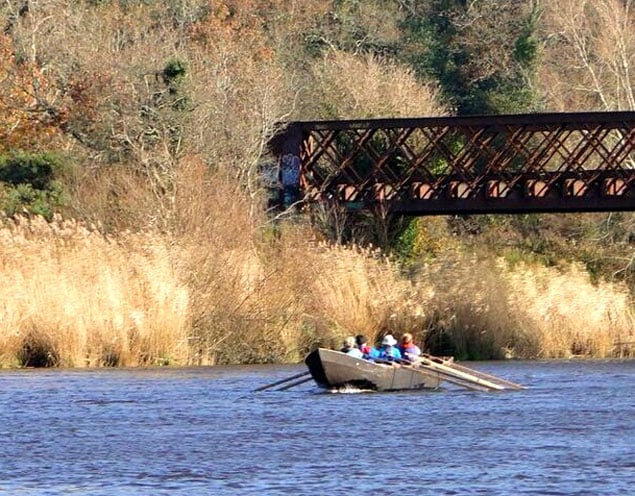 Even a rusty railway bridge is brought to life by the vivid sunshine. Photo: Jack O’Keeffe
Even a rusty railway bridge is brought to life by the vivid sunshine. Photo: Jack O’Keeffe
They have returned to Cork with an abiding impression of a region in which rich farmland is intercut by river valleys of perfection, the winding waterways enlivened every so often by going through steep tree-lined gaps in the hills.
The smooth running of this friendliest of invasions was made possible by warm hospitality in every place visited, and full encouragement from all background organisations involved, with Naomhoga Chorcai particularly wishing to thank Waterways Ireland, Kennedy Boutique Hotel, The Otter Inistioge, Donnelly’s Pub, Kilkenny CC, New Ross Marina, New Ross Port, Graiguenamanagh RC, and New Ross RC AOK Soup Kitchen.
Glen Hansard & Crew Talk Camino Voyage On Late Late Show
Glen Hansard, Brendan Begley, Liam Holden and Brendan Moriarty were on The Late Late Show this past Friday evening (16 November) to talk their incredible adventure rowing and sailing a traditional curragh to Spain.
The ‘modern day Celtic odyssey’ is the subject of a new documentary, The Camino Voyage, that had its Irish premiere earlier this year. Footage from the expedition was also featured on TG4 in the spring of 2017.
Hansard, an Oscar-winning songwriter and frontman of rock band The Frames, tells Late Late host Ryan Tubridy how his five weeks on board the Naomhóig na Tinte along the coast of northern Spain sparked a reconnection with his sense of what it means to be Irish.
It also inspired a feeling of ‘meitheal’ with the late Danny Sheehy and his Kerry crew mates — the same spirit of community that’s seen in the Meitheal Mara boat-building collective in Cork.
The 20-minute interview is available for viewers in Ireland to watch back on the RTÉ Player till Sunday 16 December.
Launch of Migrant–Built Traditional Currach in Cork
In July of this year, a group of adults arrived in the boatyard at Meitheal Mara in Crosses Green in the heart of Cork City to learn about a proposed new boat-building programme. For 25 years now Meitheal Mara has been engaging with community groups all over Cork and working with disadvantaged and socially excluded individuals, providing them with boat-building and woodwork training. In a slightly new departure from this, in the summer of 2018, Meitheal Mara began a boat-building programme with a group of people living in direct provision.
The group of prospective boat-builders that arrived in Meitheal Mara’s workshop that day were a diverse bunch of people, coming from all over the world, and bringing with them a broad range of skills and experience. While some of them had prior experience of working with their hands, having previously worked in engineering and in construction, for others this was their first time doing anything of this nature. However, while they differed in their skill levels they all shared a similar interest in and passion for the work. Every week the workshop was filled with high motivation, great enthusiasm and fierce concentration to create a brilliantly finished vessel. Séamus O’Brien, Meitheal Mara’s workshop manager, described the group as ‘mad keen to learn’. He admits that at the beginning he wasn’t sure of how well the project would work. ‘Normally groups come to the workshop with their own project worker, someone to recruit and motivate the participants. In this case, we had to go to the accommodation centres ourselves to try to spread the word about the project.’ While this meant a good deal of additional work for the Meitheal Mara staff, Séamus is satisfied that all of this work paid off. ‘The project was a lovely experience. We all gained a lot from it.’
The boat-building course was part of a project entitled ‘Making a Connection through Currachs’, funded by the Heritage Council as part of the European Year of Cultural Heritage. Through their regular weekly participation, the group got to know every single step of the currach-build process, from cleaning and prepping the hazel rods to tarring the skin of the boat. The project also gave the group an awareness of a significant element of the cultural and maritime heritage of their new country of residence. It was clear to Séamus that this element of the currach-build intrigued the participants. ‘They were all very curious and really interested in our culture as well. They asked lots of questions about the currach all through the project’.
In fact, as part of Heritage Week in August, these novice boat-builders hosted members of the public at an Open Day in Meitheal Mara, demonstrating their newly acquired skills and knowledge to members of the public.
Now their boat a Dunfanaghy-style currach is completed and ready to be launched. On one of their last sessions in the workshop, the group sat down together to try to choose a name for their boat. There were lots of different suggestions in a lot of different languages but in the end, the boat-builders decided that an Irish name for their traditional Irish boat was most fitting and so ‘Bád Chorcaí’ (Cork Boat) was selected.
Bád Chorcaí will be launched at Lapps Quay pontoon at 4 pm on Tuesday 16th October. The boat will be joined on the water by Meitheal Mara’s fleet of Dunfanaghy currachs so that the boat-builders, their families and all of their supporters will have a chance to experience currach rowing.


























